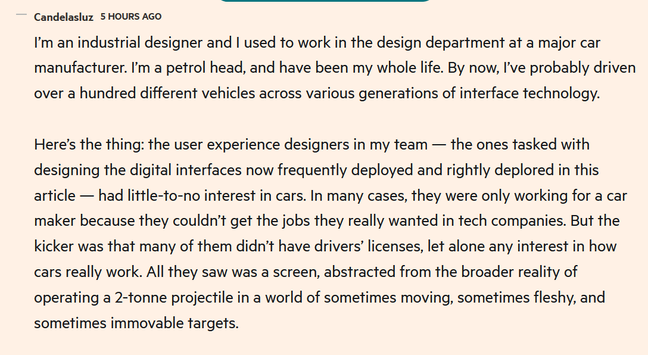@CoolSWEng I’m inclined to believe this is almost certainly not the reason.
For one thing, the odds of having a design team with no drivers in it are just pretty low. I work in tech, and in every design team I’ve ever been in I was the only non-driver. Most of the world is still too car-centric.
For a second thing, lots of good designers very often design for use cases which they themselves don’t share. You don’t have to be a pilot to design an aeroplane cockpit.
To me it sounds crushingly plausible that a car company could end up with a tech team that has few enough drivers in it that they could be overruled by the others, plus a management team that "leads by spreadsheet" enough to not know enough to overrule the tech team's design.
@rastilin @CoolSWEng Most of the designers I have worked with were not the target users of their designs. And if by chance they were, we took steps to remind everyone that “you are not your user”. It’s neither necessary nor desirable for good design work to have a design team of ‘insiders’.
I don’t believe that the answer to bad ergonomics in modern cars is “hire only designers who are petrol heads”.
@maccruiskeen Which is a fair criticism, but good designers should take that kind of thing into account whether they themselves are a publisher or not.
I’ve also used systems created by designers and non-designers that are very poorly optimised for any use case but the one that was most pressing at the time it was made.
There are all sorts of reasons that bad designs come to be though.
@paddyduke @CoolSWEng @maccruiskeen
Is it really not desirable for the designer to understand their users and product? I feel this entire thread is effectively about the consequences of designers that don't use their own product.
I feel that it often boils down to the question of "if you yourself wouldn't use your own product, why should anyone else"?
@rastilin That’s a straw man. The designer should understand the use cases of anything they design. But that’s not remotely the same thing as “being the person you’re designing for”.
If I designed things based on whether I would use it, I would probably design bad products from the perspective of everyone else. And I would absolutely bet that the designers who created these terrible car interfaces believed that they themselves would use them.
It's an appeal to authority to say that because the theory says it's good, then it must be good. Presumably the users who hate it aren't experienced enough in design to understand why the interfaces don't suck. Also if those are the designers that don't drive and have little experience with cars, does it matter what they believe they would use?
Though I suspect that yes, the fact that touchscreens can be cheaper than buttons probably also factored into the decision.Though even then, surely they can't be *that* cheap, plastic buttons are basically free.
@maccruiskeen 100%
Most likely it’s a multitude of factors encompassing the designers themselves, the environment and resources available to them, and pressures from other parts of the business.
I’m only saying that I don’t believe the whole problem is down to a handful of user interface designers not being enthusiastic drivers.
Then there's the assembly in the factory, the testing, and the maintenance burden.
There are reasons why car companies have slathered over the touchscreen as a "universal input device", and each of them has a shiny dollar sign on them.
From a usability point of view, as well as a safety point of view, they are a complete disaster. Thankfully drivers are rebelling.
The touchscreen was going to be in the car regardless for other UX reasons. It also can perform the functions of the physical buttons. The cheap/free buttons still need to be manufactured, stored and fitted. Plus, all those buttons need electronics which also has the above costs.
If you look at it purely on a spreadsheet it makes immediate sense.
